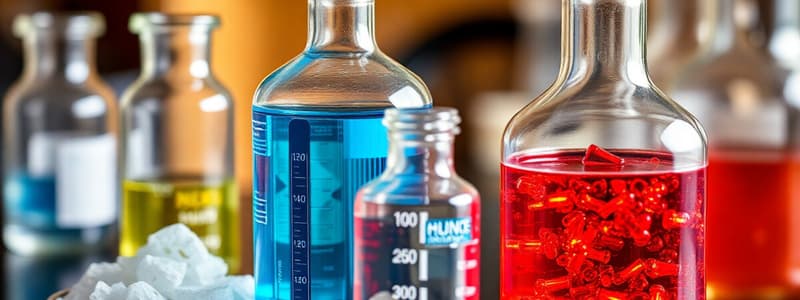Podcast
Questions and Answers
Which of the following observations about a T-shirt is a quantitative property?
Which of the following observations about a T-shirt is a quantitative property?
- It will shrink in 70 °C water.
- It is 60 cm long. (correct)
- It is red and grey in colour.
- It is soft and stretchable.
Which combination of properties is important for mountain bike frames?
Which combination of properties is important for mountain bike frames?
- Hard, brittle, corrosion resistant
- Soft, lightweight, ductile
- High density, malleable, ductile
- Hard, malleable, low density (correct)
Which of the following describes a qualitative property of butter?
Which of the following describes a qualitative property of butter?
- It is soft. (correct)
- It weighs 500 g.
- It is white in colour. (correct)
- It has a high density.
What characteristic is true for aluminum foil as described in the content?
What characteristic is true for aluminum foil as described in the content?
Which of the following items is categorized as a qualitative observation?
Which of the following items is categorized as a qualitative observation?
What is the formula for calculating density?
What is the formula for calculating density?
In the density activity, what is the purpose of comparing observed densities with actual densities?
In the density activity, what is the purpose of comparing observed densities with actual densities?
What items are likely involved in measuring density during the activity?
What items are likely involved in measuring density during the activity?
If you have a metal with a mass of 100 g and a volume of 20 cm³, what is its density?
If you have a metal with a mass of 100 g and a volume of 20 cm³, what is its density?
What is the significance of the warm-up activity on September 20, 2024?
What is the significance of the warm-up activity on September 20, 2024?
What is a physical property of copper wire?
What is a physical property of copper wire?
Which of the following examples best demonstrates a physical change?
Which of the following examples best demonstrates a physical change?
Which property describes both sugar and toothpaste?
Which property describes both sugar and toothpaste?
Which characteristic is NOT associated with a candle?
Which characteristic is NOT associated with a candle?
Which of the following scenarios illustrates a change of state?
Which of the following scenarios illustrates a change of state?
What is the diameter of the cylinder?
What is the diameter of the cylinder?
What is the formula used to calculate the volume of a cylinder?
What is the formula used to calculate the volume of a cylinder?
What is the first step in finding the radius of the cylinder?
What is the first step in finding the radius of the cylinder?
If the mass of the cylinder were doubled, what would be the new density assuming the volume remains the same?
If the mass of the cylinder were doubled, what would be the new density assuming the volume remains the same?
What approximate value is obtained when calculating the volume of the cylinder?
What approximate value is obtained when calculating the volume of the cylinder?
Which property is described as having a numerical value?
Which property is described as having a numerical value?
Which of the following observations is an example of a qualitative property?
Which of the following observations is an example of a qualitative property?
How would you classify the observation 'It will shrink in 70 °C water'?
How would you classify the observation 'It will shrink in 70 °C water'?
Which observation is considered a quantitative property?
Which observation is considered a quantitative property?
What differentiates quantitative properties from qualitative properties?
What differentiates quantitative properties from qualitative properties?
Flashcards
What is density?
What is density?
Density is a property that describes how much mass is packed into a given volume.
Density Formula
Density Formula
The formula for calculating density is D = M/V, where D represents density, M represents mass, and V represents volume.
Density Units
Density Units
Density is measured in units of grams per cubic centimeter (g/cm³).
How to Calculate Density
How to Calculate Density
Signup and view all the flashcards
Identifying Metals Using Density
Identifying Metals Using Density
Signup and view all the flashcards
Qualitative Property
Qualitative Property
Signup and view all the flashcards
Quantitative Property
Quantitative Property
Signup and view all the flashcards
Malleability
Malleability
Signup and view all the flashcards
Ductility
Ductility
Signup and view all the flashcards
Density
Density
Signup and view all the flashcards
Identifying Substances Using Density
Identifying Substances Using Density
Signup and view all the flashcards
A T-shirt is red and grey.
A T-shirt is red and grey.
Signup and view all the flashcards
A T-shirt is 60 cm long.
A T-shirt is 60 cm long.
Signup and view all the flashcards
What are physical properties?
What are physical properties?
Signup and view all the flashcards
What is a physical change?
What is a physical change?
Signup and view all the flashcards
Give some examples of physical properties.
Give some examples of physical properties.
Signup and view all the flashcards
Give some examples of physical changes.
Give some examples of physical changes.
Signup and view all the flashcards
How is a chemical change different from a physical change?
How is a chemical change different from a physical change?
Signup and view all the flashcards
Study Notes
Agenda
- Warm Up
- Take up yesterday's work, page 182 #1 - 5.
- Activity: Density
- Determine the density of each unknown metal.
- Compare the observed densities with the actual densities of metals to determine the identity of the unknown metals.
- $D = \frac{M}{V}$
Studying That Suits You
Use AI to generate personalized quizzes and flashcards to suit your learning preferences.
Description
Test your knowledge on the physical and chemical properties of various materials, including T-shirts, butter, aluminum foil, and more. This quiz covers qualitative and quantitative observations, density calculations, and physical changes. Gain a better understanding of how these properties are critical in different applications.




